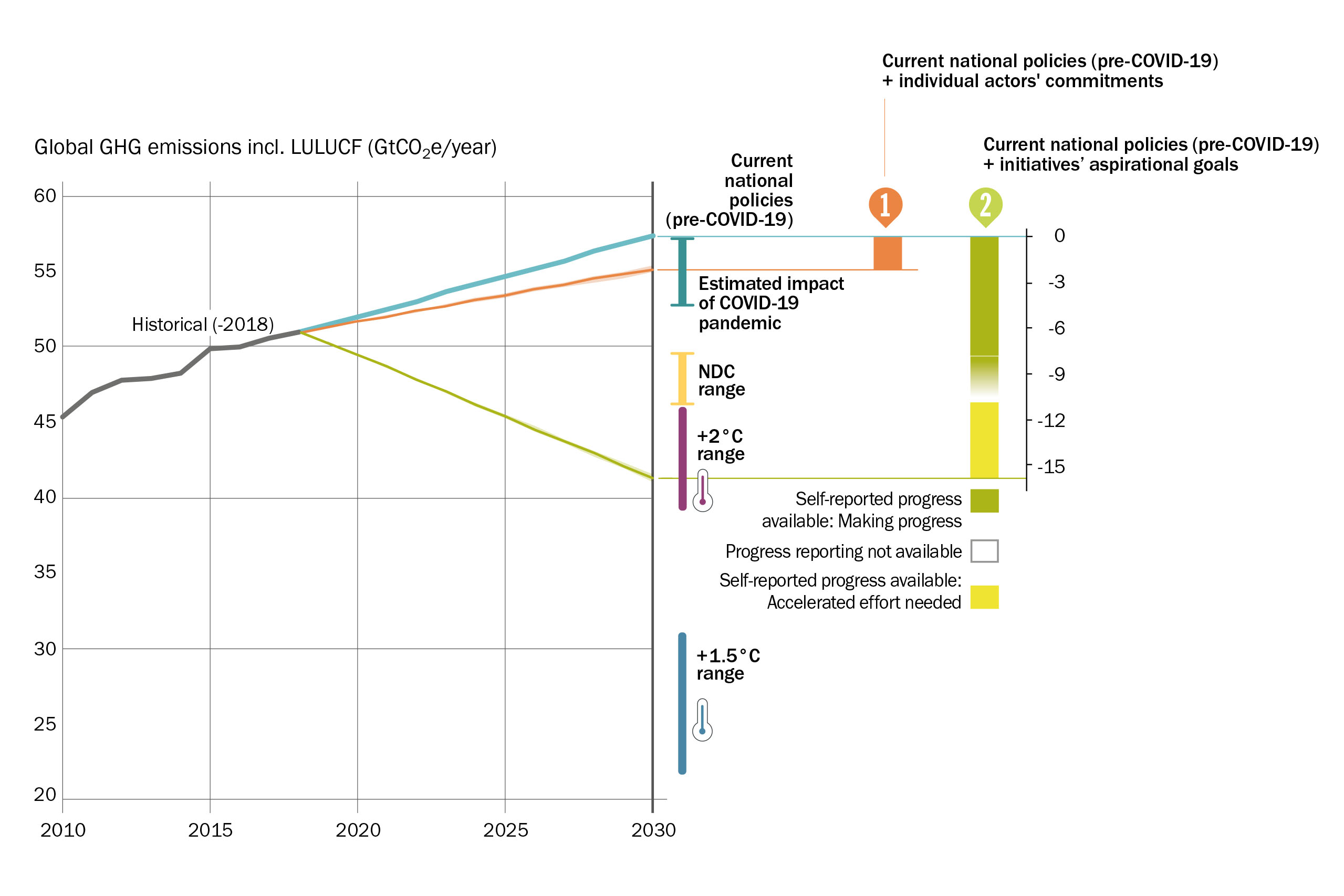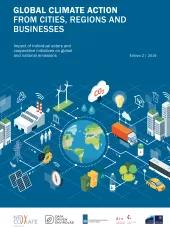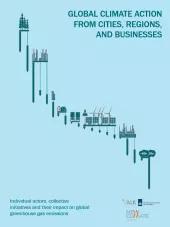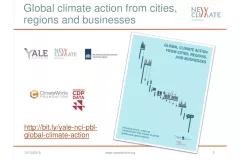This report is the third and the latest edition of the series since 2018 that take stock of climate action by cities, regions and businesses and their global aggregate impact on greenhouse gas emissions. The 2021 edition focuses on the progress of non-state and subnational actors toward their emissions reduction targets.
Main findings:
In this report, we focus on subnational and non-state action in ten major emitting economies: Brazil, Canada, China, the European Union (EU-27) plus the United Kingdom (UK), India, Indonesia, Japan, Mexico, South Africa, and the United States (US). We find that:
- The landscape of non-state and subnational climate action continues to broaden even during the COVID-19 pandemic. Both the number of individual non-state and subnational climate actions, as well as the participation in international cooperative initiatives (ICIs) are growing. Subnational actors with post-2020 targets analysed in this analysis cover 11% of the global population and 12% of global emissions. In addition, over 800 firms in the ten major economies have set quantifiable post-2020 targets – with a combined revenue totalling around USD 13 trillion, just under the size of China’s GDP. 297 ICIs continue to grow in impact and size, covering 13,583 business, over 4,510 investors, 13,012 cities and regions, and 2,424 NGOs.
- The aggregate 2030 ambition of non-state and subnational climate actions has not yet changed significantly (Figure 1). This picture may quickly change in the coming years as more actors set 2030 targets that are in line with mid-century net-zero emissions goals. While there are more non-state and subnational actors committing to 2030 emissions reduction targets and long-term net-zero emissions targets, our updated analysis did not clearly demonstrate that the collective 2030 ambition of non-state and subnational climate actions has increased since our 2019 analysis. We show that the full implementation of GHG emissions reduction targets by individual cities, regions and companies could lead to 2.0 to 2.5 GtCO2e/year of additional emissions reductions compared to the baseline pre-COVID “current national policies scenario” in 2030. In addition, our updated results show that ICIs’ aspirational goals, if fully implemented, could lead to a reduction of 16 GtCO2e/year below current national policies scenario emissions projections for 2030, leading to total emission levels close to the range for a 2°C emissions pathway.
Potential global greenhouse gas (GHG) emissions reductions resulting from full implementation of individual actors’ targets (“current national policies (CNP) plus individual actors’ commitments” scenario) and international cooperative initiatives’ goals (“CNP plus initiatives’ aspirational goals” scenario) up to 2030.
- Non-state and subnational actors are making progress towards their 2030 targets, but to varying degrees. Emissions trends in recent years suggest that more effort is needed for these actors to collectively achieve their targets. Whether non-state and subnational actors are following through on their emission reduction pledges is critical to understanding what progress is being delivered. While the momentum of non-state and subnational climate actions continues to build, this report finds that there is limited evidence of this ambition corresponding to realised impact, given limited GHG inventory data by which to assess progress.
- EV sales targets of car manufacturers would lead to higher share of EV sales than expected from national policies of the EU, China and the United States. A significant share of car manufacturers’ emissions comes not from their own operations but from their value chain, notably the use of their products. Our analysis shows that car manufacturers could bring about transformational change if they fulfil their goals on car EV sales targets and improve fossil fuel cars in line with national estimates.
Recommendations:
Based on the above findings, we present several recommendations:
- Data and monitoring
- There is an urgent need for greater transparency and reporting to close the growing ‘accountability gap’. While momentum of non-state and subnational climate actions continues to build, this report finds that there is limited evidence of this ambition translating into realised impacts.
- Historical time series data are required to examine trends. Specifically on the continuous tracking of non-state and subnational actions, progress assessments would greatly benefit from consistent time series of historical GHG emissions.
- There is a need for holistic and comprehensive data encompassing multiple aspects of progress tracking. While our report provided a first progress tracking, it is limited to a few dimensions and indicators (i.e., emission reductions) of the “full cycle” of progress. Ideally, actors would report details on a range of inputs (e.g., policies, strategies) as well as outputs (e.g., activities and products) that would allow for a more complete understanding of progress.
- Implementation
- Early evidence suggests limited progress towards 2020 targets, requiring greater implementation towards post-2020 targets. Analysis of reported greenhouse gas emission inventories indicates that only half of city governments and 80% of companies delivered on their 2020 emission reduction targets. While limited 2020 emissions data were available and it is possible greater achievement was realized, this modest progress suggests that cities, regions, and companies will need to accelerate their actions to stay on track for or achieve their 2030 targets.
- Ambition
- Aligning mid-term ambition with national governments’ long-term net-zero goals is necessary. There is an important opportunity for non-state and subnational actors to enhance their ambition further for the mid-term future in accordance with the Paris Agreement’s long-term goal of global net-zero emissions. Our findings from the progress assessment suggest that a substantial number of actors can already strengthen their mid-term targets.
- Subnational and non-state actors can seize the post-COVID opportunity to develop long-term decarbonization strategies. Together with national governments, non-state and subnational actors can also seize COVID-19 recovery opportunities to lay a solid foundation for transition towards net-zero emissions. Several recent studies show that cities, regions and businesses can play a crucial role in materialising sustainable and resilient recovery.









